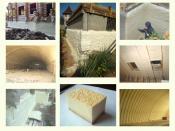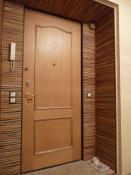Search
Login
Recommended
Bituminous tile, installation of bituminous tile step by step instructions
The very name of the material, bituminous, or flexible, tiles, is quite eloquent, it initially suggests that the material should be flexible, ductile, soft. It is also clear that the material for the manufacture of soft roofs is bitumen. Roofing shingles, the price of which is quite affordable, are often used in construction with a modest budget, but the intricate shape and complex geometry of the roof of an expensive mansion may also require the use of this attractive-looking and fairly durable material.
Content:
- How do the sheets of shingles look and what structure video
- Roof from bituminous tiles - installation features
- Laying bituminous tiles - we prepare the crate and the lining carpet
- Technology of installation of bituminous tiles
- How to attach soft tiles video
- Installation of flexible tiles Shinglas and its features video
- That the roof served for a long time
How do the sheets of shingles look and what structure

In appearance, the sheets of bituminous tiles are rectangles, they have the shape of a plate (shingle), along the edge they are decorated with petals of different shapes. Bituminous roofing material from different manufacturers has a variety of colors, can vary significantly in size and print, but the structure of the tiles remains standard.
The basis for the tiles is fiberglass fabric, impregnated with modified bitumen, the use of this modern raw material allows to give the roofing material improved qualities:
- good viscosity at high temperatures,
- preservation of elasticity - with negative ones.
A layer of an armor substance is applied to the front layer of the tile, then a small fraction of stone chips or thin metal sheets (zinc-titanium or copper) are pressed into it.

The finished material is a layering:
- in the center - fiberglass with bitumen impregnation, bitumen layer,
- on the front side: sheet metal or stone granulate,
- on the inside - silicon sand spraying, adhesive layer, protective film.
The multi-layered material allows it to cope perfectly with loads, precipitation, temperature effects, ultraviolet radiation from the sun.

If you analyze the quality of the roofing material, it can be argued that a flexible bitumen tile has the following properties:
- a variety of shades, patterns and shapes,
- aesthetic look
- relatively light weight
- a sufficiently high level of noise absorption, higher than that of a metal analog,
- the possibility of mounting on surfaces of complex shape and curved sections,
- simple installation process,
- the ability to provide waterproofing,
- excellent water repellent properties.
On the shingles and its features - in the video:
Roof from bituminous tiles - installation features
To get high-quality coverage, you should take note of a few simple rules:
- storage of bituminous tiles before the installation of the roof should be carried out in pallets stacked in stacks of 16 rows in a dry and warm room.
- lining material is stored in rolls, installed vertically, preferably in a heated warehouse.
It is recommended to install bituminous tiles on warm days, the minimum temperature can be +5 C. If it is cool outside, then the roofing materials are first placed in a well-heated storage room.
It is recommended to use bitumen coating on roofs with a slope of 15 to 85 degrees. When calculating the amount of material, they are guided by the following rule: the greater the slope of the roof, the less material it will require. The calculated surface indicated on the packaging relates to roofs whose slope is 45 degrees.

When laying shingles of tiles, it is forbidden to use a burner, exposure to sunlight is sufficient for gluing sticky surfaces. If work is planned during the off-season, when sunny days are rare, it is recommended to stock up with special glue, such as Shingle Stick or Plastal. Removing the lower protective film is carried out immediately before laying the shingles.
Even one series does not guarantee that the color of the tiles from different packages will match perfectly, so for laying one slope you should take shingles from one package. If the circumstances are such that for laying on one ramp you have to use shingles from different packages, then it is recommended to initially plan their laying out in the form of a pattern.
Installation of bitumen tiles is not done on a concrete base or on a layer of insulation. In warm sunny weather, it is forbidden to walk on the bitumen roof - if necessary, use stairs.
Laying bituminous tiles - we prepare the crate and the lining carpet
For laying a soft roof, the construction of the lathing will be required, it must be solid, an OSB-plate, ordinary plywood or board can be used as the material for its construction.

When arranging the crate, the longitudinal side of the boards or panels is laid parallel to the ridge, it is impossible to allow that the seams between sheets of material from row to row coincide. After complete assembly of the crate, primer roofing should be laid on it, it provides high-quality waterproofing and allows you to simplify the installation of soft tiles, with a slope of the roof up to 30 degrees - they cover the entire surface of the slope only.

The rules for laying the underlay carpet vary depending on the slope of the roof, for example, if it is on the order of 15-20 degrees, then it will be necessary to overlap - approximately 15 cm vertically and 8 cm - horizontally, laying parallel to the eaves. If the primer roofing is laid in two layers, then horizontally it is desirable to leave an overlap of the order of 0.5 m, and vertically - 0.3 m.

If the roof has a slope of 20 to 85 degrees, then an overlap of the order of 5 cm horizontally and 10 - vertically will be required, fastenings are made along each joint line, droppers are installed on the soil layer along the edges and cornices, in the future they will protect the roof from ice formation. In valleys, overlaps should be vertical - about 30 cm, on the sides - about 15 cm.
Technology of installation of bituminous tiles
There are usually no special difficulties in the process of installing bituminous tiles, of course, if you treat the work with due attention and perform all the steps as accurately as possible.

To perform the installation beautifully, it is recommended that you first mark out the guide lines on the primer field that you can orientate yourself during the work. For each four rows, a horizontal line should be drawn along the ramp. First of all, they mark the areas on which the windows, the exits of the ventilation pipes, etc. are placed.
If there are no extraneous elements, then first the middle vertical line is beaten with a cord, grated with chalk, then, with a step in four rows, the following are noted.
How a flexible bituminous tile fastens
It is recommended to use roofing nails for fastening bitumen material, their main differences are large hats, of the order of 0.8 cm, the length of the nail should be 2.6 cm. For fastening one shingle, 4 studs, metal, with a corrosion-resistant coating will be required.
They should be hammered by stepping back 2.5 cm from the side edge of the shingle and 14 from the bottom. It is important to determine the depth of nailing - a too deep recessing of the cap into bitumen material will lead to the appearance of depressions; moisture will accumulate in them during rain. Insufficiently deep immersion of the cap will make it visible. Both options will lead to the fact that moisture will act on the metal fastener, and ultimately it will rust.

Specialists recommend paying attention to special nails:
- rough, characterized by the presence of a cone-shaped head restraint, which allows to wedge the nail, which provides a sufficiently strong fastening of the shingle,
- screw, with a groove cut along, which provides increased fastening strength.
In some cases, installation is performed without preliminary laying of the roofing, then brackets can be used for fastening. In this case, you need to get a stapler.

It will be required to acquire special glue even if the installation of the tile will be carried out in the summer, it will be required for the arrangement of the endow lines, places of abutment to windows and walls, and the ridge.
Apply glue with a syringe or spatula. For its hardening, a temperature of the order of + 10 C is required, therefore it is recommended to apply the adhesive preheated, this is important for working at low air temperatures.
For a quick setting, the glued shingle can be heated with a hot air gun, you can not use the burner! If the weather is hot outside, then hot air gun treatment is not needed. It is better to press down the surface with force, the gluing will become more durable.
About the procedure for constructing a roof from flexible tiles - in the video:
Installation of flexible tiles Shinglas and its features
Begin installation after completion of preparatory work. Note that one person can handle the styling process. They begin laying with the Shinglas ridge-eaves tiles, for the starting strip you can also use ordinary sheets, but previously cut, with cut petals.

Experts recommend: if shingles from several packs are used on the ramp, then before laying them they should be mixed thoroughly, laying out fragments slightly different in color is recommended randomly, ideally - the picture should turn out to be abstract.

Remove the protective film from the wrong side of the shingle immediately before laying it.
It is advisable to start fastening the first row from the center, moving to the edges - this will simplify horizontal alignment. For work, the same galvanized nails are used.
Subsequent rows are also stacked from the center, but always with an offset, enough - half the petal. With proper installation, the level of the lower edge of the petals should coincide with the upper edge of the cutouts of the previous row. In places where there is no self-adhesive layer, a layer of bitumen mastic is applied to the shingles. She is treated with the lines of slices of shingle along the edge of the ramp.

Additionally, insulation will need to process the exit sections of the chimneys and ventilation pipes. To coat with mastic all sheets is not recommended - this will lead to a loss of decorative roofing.
On the installation of flexible tiles Shinglas - on video:
That the roof served for a long time

To maximize the service life of the soft roof and ensure its attractive appearance, you will need to periodically perform simple care procedures:
- in spring and autumn, inspect the roof for leaks,
- rubbish that has fallen on the roof should be removed using a soft brush,
- if there are objects on the roof with stitching or cutting edges, remove them manually so as not to damage the top layer of the tile,
- to ensure a normal flow of water, it is desirable to systematically clean the gutters,
- light snow shovels should be used to clear accumulated snow
- minor repairs of fragments of the structure should be made in a timely manner.





